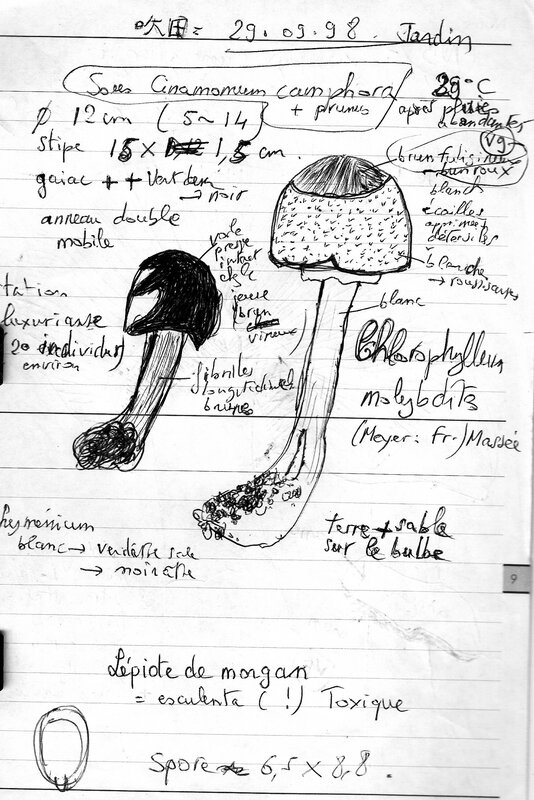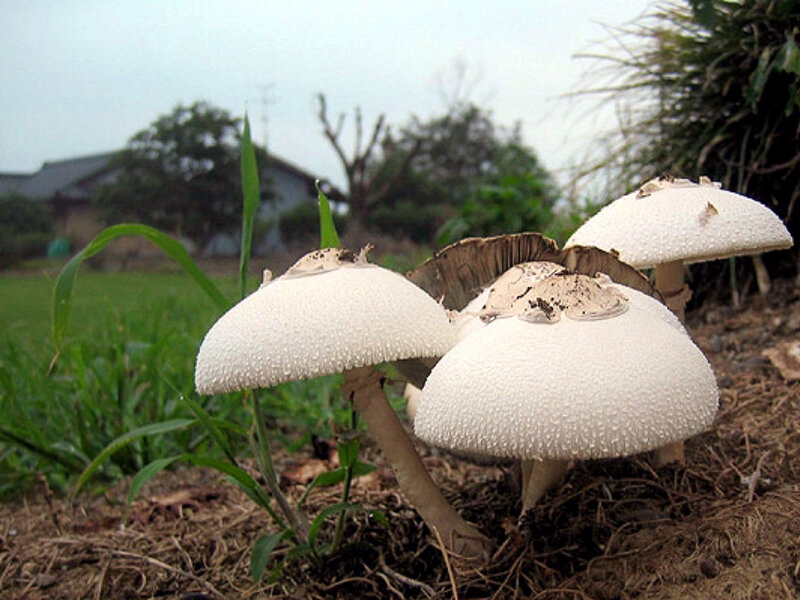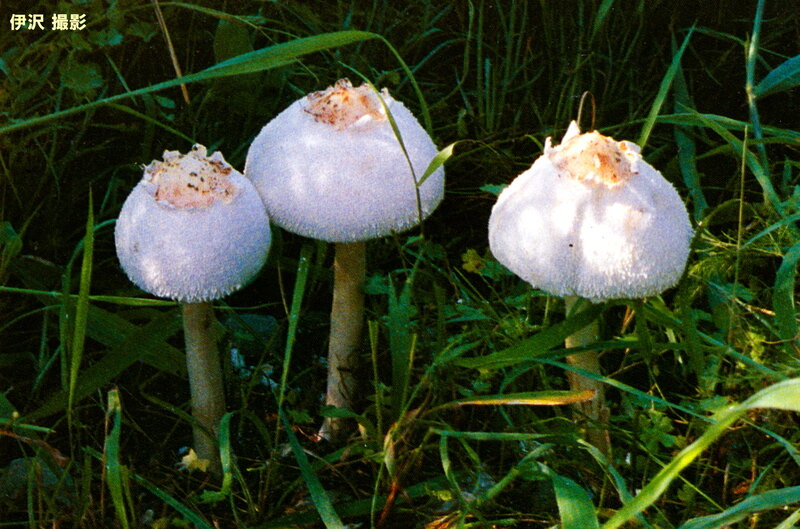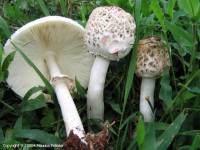Lépiote de Morgan オオシロカラカサタケ





- Basidiomycota / Homobasidiomycetes / Agaricales / Agaricaceae
- Synonymes : Agaricus molybdites (G.Mey.) Sacc. 1887 ; Mastocephalus molybdites ( G.Mey.) Kuntze 1891 ; Leucocoprinus molybdites (G.Mey.) Pat. 1899 ; Macrolepiota molybdites ( G.Mey.) Moreno 1995 ; Lepiota morganii Peck 1887 ; Chlorophyllum esculentum Massee 1898 ; Annularia camporum Speg. 1898 ; Agaricus guadelupensis Pat. 1899
- Chair blanche à plus ou moins rougeâtre. Odeur et saveur, pas de caractères distinctifs.
- Spores : ovoïdes à pore large et trapu, lisses, dextrinoïdes, 8-10 (12) x 6-8 (9) µm. Cheilocystides claviformes à fusiformes ventrues, à + ou - sphéropédonculées, 20-30-40 x 10-15-20 µm. Trame à hyphes variables. Epicutis de type trichodermique à hyphes + ou -dressées ou parallèles , peu cloisonnées, boucles rares ou plutôt hyméniales, parfois nulles.
- Ecologie : en zone tropicale, vient dans les parcs et jardins, sur pelouse ( Amérique, Océanie, Afrique, Asie, etc.), uniquement en serre en jardins botaniques ou en pots de fleurs en climat tempéré.
Remarques : ( voir liste des récoltes )
- Toxique :
Chlorophyllum molybdites has been a frequent cause of mycetism in all continents except Europe, as has been reported by many authors, viz. Avizohar-Hershenzon (1967), Natarajan and Kaviyarasan (1991) and Graff (1913, 1927) for Asia; Grgurinovic (1997), Southcott (1974) and Young (1989) for Australia; Arora (1991), CFSAN (2003), Eilers and Nelson (1974), Lehmann and Khazan (1992), Levitan et al. (1981), Pérez-Silva and Herrera (1986) and many others for North America; and Floch et al. (1966) and Singer (1969, 1975) for South America.
Walleyn and Rammeloo (1994) summarise all references for Africa, and Reid and Eicker (1991) provide references for most continents. Chorophyllum.molybdites in North America is the species that causes more poisonings than any other mushroom, particularly because of its resemblance with C. rachodes (Vittad.) Vellinga and its ample occurrence in lawns in urban areas (Arora 1991, Lehmann and Khazan 1992). Most cases of mycetism in residents of tropical metropoles are caused by this species (Courtecuisse and Duhem 1994).
Its distribution is indeed mainly tropical-subtropical. In Europe it occasionally appears in hothouses and other artificially heated environments (Dennis 1952: 463, Vellinga 1990, Watling 1991). In America its northernmost occurrence indoors is in south-eastern Canada (Reid and Eicker 1991) and the southernmost occurrence is in the Argentinean province of Buenos Aires (Reid and Eicker 1991, Singer and Digilio 1952). Like many other species with an intercontinental distribution, it has been described under many names and extensive lists of synonyms were supplied by Grgurinovic (1997), Pegler (1977, 1983), Reid and Eicker (1991), Singer (1975), and others. Altogether there are no less then eight or nine epithets for this species, viz. camporum, congolensis, esculentum, glaziovii, guadelupensis, molybdites, morganii, ochrospora, and probably also chlorospora. It should be noted that C. globosum (Mossebo) Vellinga, from western Africa (Mossebo et al. 2000), is indeed a different species (Vellinga and de Kok 2002, Vellinga et al. 2003), though there might be an older name for it. - In South America the species has been reported, south to north - listing all countries - from Argentina (including type of Annularia camporum Speg.), Brazil, Venezuela, Guiana (Dennis 1952, Pegler 1983; types of Chlorophyllum esculentum Massee and Lepiota ochrospora Cooke and Massee), French Guyana (Courtecuisse et al. 1996) and Trinidad (Reid and Eicker 1991 and references therein). We have not seen any published records of Chile, Bolivia,
- Références bibliographiques : CD 716 ; DM Hors Séries 3 p. 126 ; IH1 247 ; IOH p. 181 ; Rogers Mushrooms ;
- Commentaires : Une seule espèce principale ,exotique ou rarement récoltée dans les serres en Europe. Principal responsable d'intoxication chez les métropolitains vivant en région tropicale (en raison de sa ressemblance avec Macrolepiota rhacodes)
Contributeur principal : Daniel Gramain
9/09/1998 DRG Nos récoltes au Japon :
| Suita, Kansaï, Japan | Sol | - | Jardin, dans les bordures sableuses, sous camphrier (Cinnamomum camphora) et Prunus ornementaux, une vingtaine de spécimens, sosies de rhacodes de grande taille. Chap. 5-14 cm, blanchâtre, recouvert dans la jeunesse de la quasi totalité du voile général apprimé, brun vineux, avec l'âge ne couvrant plus que le disque et devenant brun roux à brun fuligineux. Le reste du chapeau parsemé de méchules apprimées, détersiles, blanches puis roussissant. Stipe 15 x 1,5 cm, blanchâtre, à fibrilles longitudinales brunes, anneau double mobile, blanc à la face supérieure, brunâtre sur la face inférieure. Lames blanches, tardivement (24-36h) verdâtre sale. Chair douce, Gaïac ++ vert dense, puis noir. Spore 6,5 x 8,8 µm |
|




/http%3A%2F%2Fstorage.canalblog.com%2F36%2F18%2F1309869%2F118973748_o.jpg)
![Termites et Champignons de Roger Heim [シロアリときのこ]](https://image.canalblog.com/iWxGETQBa2Kd4tXsT_U77lGUD2k=/400x260/smart/filters:no_upscale()/http%3A%2F%2Fstorage.canalblog.com%2F05%2F23%2F1309869%2F105008073_o.jpg)
/http%3A%2F%2Fwww.mycodb.fr%2Fthumbs%2FChlorophyllum_molybdites_2004_mp_1.jpg)
/https%3A%2F%2Fstorage.canalblog.com%2F66%2F68%2F1309869%2F130448355_o.jpg)